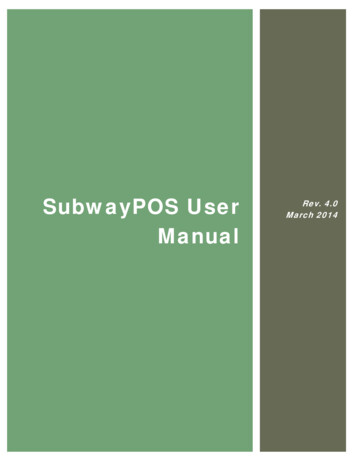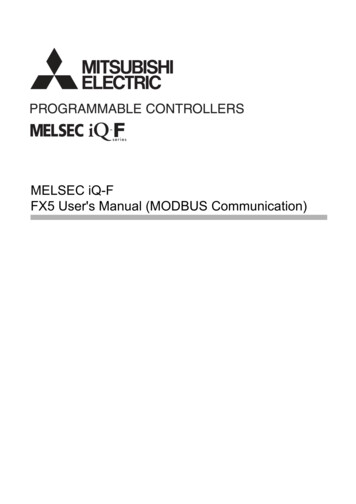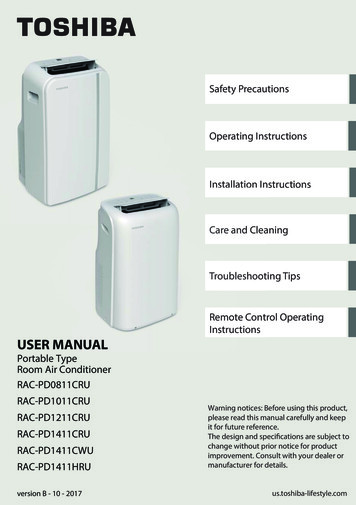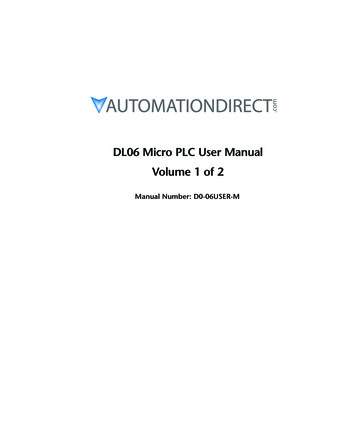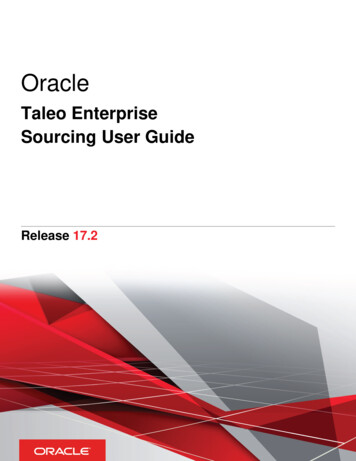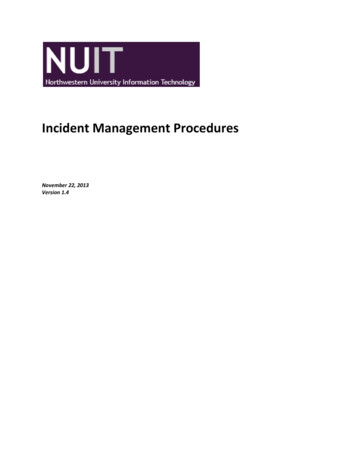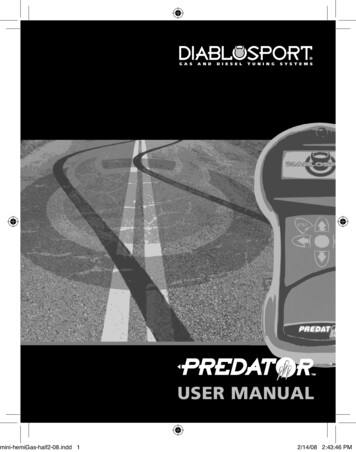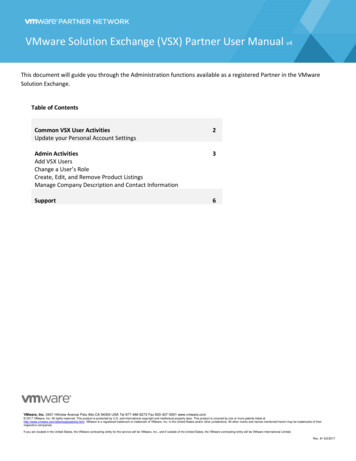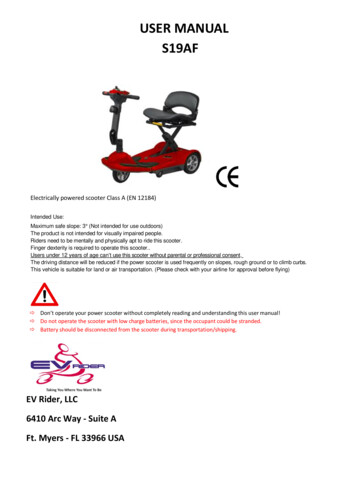
Transcription
USER MANUALS19AFElectrically powered scooter Class A (EN 12184)Intended Use:Maximum safe slope: 3 (Not intended for use outdoors)The product is not intended for visually impaired people.Riders need to be mentally and physically apt to ride this scooter.Finger dexterity is required to operate this scooter.Users under 12 years of age can’t use this scooter without parental or professional consent.The driving distance will be reduced if the power scooter is used frequently on slopes, rough ground or to climb curbs.This vehicle is suitable for land or air transportation. (Please check with your airline for approval before flying) Don’t operate your power scooter without completely reading and understanding this user manual! Do not operate the scooter with low charge batteries, since the occupant could be stranded. Battery should be disconnected from the scooter during transportation/shipping.EV Rider, LLC6410 Arc Way - Suite AFt. Myers - FL 33966 USA1
CONTENTSSafety InstructionsElectromagnetic Interference (EMI)Transporting the ScooterSpecificationsComfort AdjustmentControl Panel OperationRiding on the RoadEmergency Charging ProcedureCharging InstructionsBattery Instruction and MaintenanceScooter Maintenance and RepairTroubleshooting and Fault RepairWarrantyscooter in traffic.Do not make sharpturns or sudden stopswhile riding yourscooter.Do not attempt toclimb curbs greaterthan the m a x i m u mr e c o m m e n d e d inDo not remove yourhands and legs fromthe scooter whenriding the scooter.Do not ride yourSAFETY INSTRUCTIONSthe specs.Always use a seat belt,and keep your feet onthe scooter at all times.Never operate thescooter while you areunder the influence ofalcohol.Do not ride yourscooter during snow inorder to avoidaccidents.Never use mobilephones or radiotransmitters such aswalkie-talkies.Make sure that thereare no obstaclesbehind you whilereversing your scooter.Do not allowunsupervised childrento play near thisequipment while thebatteries are charging.
Warning – Do not operate your scooter for thefirst time without completely reading andunderstanding this owner’s manual.1.Do not operate the scooter on the road. Obey alllocal pedestrian traffic rules. Be aware that itmay be difficult for traffic to see you when youare seated on the scooter. Wait until your pathis clear of traffic, and then proceed with extremecaution.2.To prevent injury to yourself or others, alwaysensure that the power is switched off whengetting on or off of the scooter.3. Always check that the drive wheels areengaged (drive mode) before iding. Do notswitch off the power when the scooter is stillmoving forward. This will bring the scooter toan extremely abrupt stop.4.5.10.Consult w i t h your physician if you aretaking prescribed medication or if you haveany certain physical limitations. Somemedications and limitations may impair yourability to operate scooters in a safe manner.Consult with your physician if you are takingany medication that may affect your ability tooperate your scooter safely.11. Do not drive or sit on the scooter when infreewheel mode.12.Do not remove the anti-tipper.13. Always switch off the scooter and chargerbefore doing any work or using any tools onthe scooter.14.Do not climb a gradient at an angle. Alwaysdrive straight up a gradient, as this greatlyreduces the risk of tipping or a fall. Do notclimb a gradient steeper than 6º.Do not use this product or any availableoptional equipment without first completelyreading and understanding these instructions. Ifyou are unable to understand the warnings,cautions or instructions, contact your dealerbefore attempting to use this equipment,otherwise injury or damage may occur.15.Do not drive backwards down any step, curb orother obstacle. This may cause the scooter to tipor fall.16.Always reduce your speed and maintain astable center of gravity when corneringsharply. Do not corner sharply when drivingscooters at higher speeds.There are certain situations, including somemedical conditions, where the scooter user willneed to practice operating the scooter in thepresence of a trained attendant. A trainedattendant can be defined as a family member orcare professional especially trained inassisting a scooter user in various daily livingactivities.17.Operating in rain, snow, salt, mist and on icy orslippery surfaces may have an adverse affecton the electrical system.18.Beware the motor may be hot after use. Donot touch or access the motor directly until ithas cooled down.6.Do not attempt to lift or move the scooter byany of its removable parts including thearmrests, seats or shrouds. Personal injury anddamage to the scooter may result.7.Never try to use your scooter beyond itslimitations as described in this manual.8.Please do not sit on your scooter while it is in amoving vehicle such as a car, bus or train.9.Keep your hands away from the wheels (tires)while riding the scooter. Be aware that loosefitting clothing can become caught in the drivewheels.19. Never sit on your scooter when it is being used inconnection with any type of lift or hoist. Yourscooter is not designed with such use in mindand any damage or injury incurred from suchuse is not the responsibility of EV Rider.21.Always ensure the scooter is fully u n foldedbefore sitting on the scooter. Do not fold thescooter until you have fully exited the scooter,and the backrest on the scooter seat is foldeddown.
ModificationsYour scooter has been designed to be as practical aspossible. However, under no circumstances shouldyou modify, add, remove, or disable any part orfunction of your scooter. Personal injury and damageto the scooter may result.1.Do not modify your power scooter in any way notauthorized by EV Rider. Do not use accessoriesif they have not been tested or approved for EVRider products.2. Get to know the feel of your power scooter andits capabilities. EV Rider recommends thatyou perform a safety check before each use tomake sure your scooter operates safely. Inspections prior to using your power scooter:1.Please check all electrical connections and makesure they are tight and not corroded.2. Please check all harness connections and makesure they are secured properly.3. Please check the brakes. Weight limitation.1.Do not exceed the weight capacity stated in theSpecification section. Exceeding the weightcapacity voids your warranty. EV Rider will notbe held responsible for injuries or propertydamage resulting from failure to observe weightlimitations.2. Do not carry passengers on scooters. Carryingpassengers on your scooter may affect the centerof gravity, resulting in a tip or a fall. Temperature1.2.Some of the parts of the scooter are susceptibleto change in temperature. The controller can onlyoperate in temperature that ranges between-25ºC 50ºC (-13ºF to 122ºF).At extreme low temperatures, the batteries mayfreeze, and your scooter may not be able tooperate. In extreme high temperatures, it mayoperate at slower speeds due to a safety featureof the controller that prevents damage to themotors and other electrical components.ELECTROMAGNETIC INTERFERENCEThe rapid development of electronics, especially inthe area of communications, has saturated ourenvironment with electromagnetic (EM) radio wavesthat are emitted by television, radio andcommunication signals. These EM wave are invisibleand their strength increases as one approaches thesource. All electrical conductors act as antennas tothe EM signals and, to varying degrees, all powerwheelchairs and scooters are susceptible toelectromagnetic interference (EMI). The interferencecould result in abnormal, unintentional movementand/or erratic control of the vehicle. Power scootersmay be susceptible to electromagnetic interference(EMI), which is interfering electromagnetic energyemitted from sources such as radio stations, TVstations, amateur radio (HAM) transmitters, two-wayradios, cellular phones and alarm systems. Theinterference (from radio wave sources) can cause thepower scooter to release its brakes, move by itself ormove in unintended directions. It can alsopermanently damage the powered scooter’s controlsystem. The intensity of the EM energy can bemeasured in volts per meter (V/m).Each poweredscooter can resist EMI up to a certain intensity. This iscalled “immunity level”. The higher the immunity levelthe greater the protection. At this time, currenttechnology is capable of providing at least 20 V/m ofimmunity level, which would provide useful protectionagainst common sources of radiated EMI.Following the warnings listed below should reducethe chance of unintended brake release or poweredscooter movement that could result in serious injury:1.Do not turn on hand-held personalcommunication devices such as citizens band(CB) radios and cellular phones while thepowered scooter is turned on.2.Be aware of nearby transmitters such as radioor TV stations and try to avoid coming close tothem.3.If unintended movement or brake releaseoccurs, turn the powered scooter off as soon asit is safe.
4.5.Be aware that adding accessories orcomponents, or modifying the powered scooter,may make it more susceptible to interferencefrom radio wave sources (Note: It is difficult toevaluate the effect on the overall immunity ofthe powered scooter).Report all incidents of unintended movement orbrake release to the powered scootermanufacturer, and note whether there is a radiowave source nearby.TURN OFF YOUR POWER SCOOTER AS SOON ASPOSSIBLE IF YOU EXPERIENCE THEFOLLOWING: Unintentional scooter movementsSPECIFICATIONModelWeight LimitOverall Dimensions(L x W x H)Folded Dimensions(L x W x H)Seat Dimensions(L x W x H)Footplate LengthWheelbase LengthTurning Radius Unintended or uncontrollable direction.Ground Clearance Unexpected brake releaseDrive W heelThe higher the immunity level the greater theprotection. Your powered scooter has an immunitylevel of 20 V/m which should protect againstcommon sources of EMI. Warning: The scooter itselfcan disturb the performance of the electromagneticfields such as emitted by an alarm system.Front WheelRear Anti-TipCastorMaximum SpeedMaximum RangeStabilityS19AF250 lb. /115kg (18 stone)86 x 42 x 84cm34” x 16½” x 33”73 x 44 x 42cm28¾” x 17½” x 16½”32 x 40 x 38cm12½” x 16” x 15”37cm14½”63cm25”78cm31”3.5cm1.4”200mm x 50mm(8” x 2”) PU Tire180mm x 40mm(7” x 1.6”) PU TireStandard3.5 mph6 kph6 miles10 km3º (Dynamic)6º (Static)TRANSPORTING THE SCOOTERWeightThe scooter is suitable for transportation in the cargohold of an aircraft.The scooter should be folded, the key removedand the battery disconnected. This will inhibit thescooter from operation.The lithium battery used in the scooter is certified assafe for airline transportation.Charger TypeControllerMotorBattery42 lb. / 19 kg (with battery)38.5 lb. / 17.5kg (without battery)2A 110/240VLi-Ion Charger50ADynamic180W24VLithium-Ion Battery24V 8.7 AhNote:Maximum Range and Speed are based on optimalconditions. User weight, battery condition, temperature,terrain, gradient, weather conditions and driving style mayall reduce the maximum range and speed.Manufacturers reserve the right to changespecifications without prior notice. Specifications of theproduct purchased may differ from those stated.
UNFOLDING THE SCOOTER1. Position the scooter with rear wheels and antitip wheels on the ground (as shown below):FOLDING THE SCOOTER1.Turn the key off and dismount the scooter.2.Fold down the backrest of the seat (highlightedon the picture below).2. Insert the key in to the ignition of the scooterand switch the scooter on.3. The red button (redarrow below) on thescooter should now beilluminated. Press it,then releasethe button and thescooter will automaticallyfold.3. The green button (greenarrow below) on thescooter should now beilluminated. Press it thenrelease the buttonand the scooter willautomatically unfold.Alternatively, press thered button on the remote.Alternatively, pressthe green button onthe remote.(In case of emergency, pressthe green button on the rearof the scooter to stop thefolding procedure. If thishappens, remove the hazardand keep your finger on thered button until the scooter isfully folded).(In case of emergency, press the red button on therear of the scooter to stop the unfoldingprocedure. If this happens, remove the hazard andkeep your finger on the green button until thescooter is fully unfolded).4. Switch off thescooter usingthe key and liftup thebackrest(highlightedin the pictureright)4.Switch the scooter off using the ignition andremove the key.
SCOOTER OPERATIONControl Panelhandle bars. Squeeze the left hand side of thewigwag paddle (BLACK) towards you and thescooter will move backwards, emitting an audiblereverse alarm. To brake, release the wigwagpaddle which will return to neutral and activatethe electromagnetic brake automatically andbring the scooter to a prompt stop. The wigwagpaddle allows you to control the speed of thescooter up to a maximum speed determined bythe Speed Dial. The further the wigwag paddle isdeflected, the faster the scooter will go (up to3.5mph).WarningDo not operate both left and right handsides of the wigwag simultaneously.You will not be able to control thescooter.How To Operate Your Scooter Key Ignition. The key ignition acts as the powerswitch for the scooter. To switch the power on,turn the key clockwise and battery gauge shouldilluminate. To switch the power off, turn the keycounter-clockwise, after which the battery gaugeshould switch off and the key can be removed.Do not turn the ignition off while riding asthis will lead to an emergency stop andpossible risk of damage or injury. Horn Button. Press the horn button to sound thehorn. Release the button to stop the horn. Thehorn is the green button located on the controlpanel. Braking – Electromagnetic Brake. Release thewigwag paddle completely, and theelectromagnetic brake will be activatedautomatically and the scooter will stop.When on a gradient, never set the vehicleto freewheel mode. The brakes will not beapplied. Speed Dial. Turn the speed dial to determine themaximum speed of the scooter. Turn the dialclockwise to increase the speed setting and turnthe dial counter-clockwise to decrease the speedsetting. Light. Press the light switch to turn on theheadlight. Press the light switch again to turn thelight off.Do not adjust the speed dial while ridingas this could result in loss of control. Donot set the highest speed while ridingindoors. Handlebar Height Adjustment. Turn the largeadjustment knob on the front of the tilleranticlockwise to release the handlebar. Slide thehandlebar to the required position, then turn theknob clockwise to secure the handlebar in place. Moving and Braking. To move forward, squeezethe right hand side (RED) of the wigwag paddlewith your hand towards you while holding theNote: the light will only operate if the power isswitched on at the ignition.
Battery Gauge. The battery gauge on the tillerconsole lights LEDs to show remaining power:Green (3 or 4 LEDS lit) - 40% - 100% capacityYellow (2 LEDs lit) - draining charge (10% - 30%)Red (1 LED lit) - immediate recharge is necessary.The remaining power indicated by the battery gaugewill vary by the driving time incurred and how youride. Repeated starting, stopping and climbing willconsume power more quickly. The gauge is shownabove.Please keep hands/fingers out of machine during thefolding/unfolding process.RIDING ON THE ROAD 1.2.3.4.Starting and RidingMake sure the scooter is fully unfolded.Make sure the tiller has been secured properly.Switch the key ignition to the on position.Check the battery gauge to check there is enoughpower for your journey. If you have any doubtabout the remaining power, recharge the batterypack before use.5. Set the speed dial to a position you feel safe andcomfortable with.6. Check the wigwag paddle and automatic brakework correctly.7. Before riding, check the environment around youis safe for you to ride your scooter.WarningBe careful while in crowded areas. Whilereversing the vehicle, be aware of people orobjects behind you. Stopping1. Release the wigwag paddle completely. Thevehicle will automatically decelerate andstop.2. Switch the scooter off at the key ignition and pullout the key.Stopping distance will vary with speed sobegin braking as early as possible.Always park on flat ground, switch off andremove the key before dismounting.The scooter is not for use as a seat in a motorvehicle.
EMERGENCY CHARGING PROCEDUREBATTERY CHARGING AND CAREThe scooter comes with an emergency charging cable.If the scooter is folded up and the battery iscompletely flat, then the standard charging socketcan be difficult to access. In this instance, theemergency charging cable can be installed to allowthe battery to be charged while the scooter is folded.Step 1. Insert the charger in to the power outlet andswitch the power on. Ensure the charger is notconnected to the scooter, and one of the chargerLEDs is lit green.The emergency charging cable is shown below:Step 2. Insert the round plug on the charger in to thecharging port of the scooter (arrow below). The LEDshould change from green to red. The LED willchange back from red to green when charging iscompleted.To install the charging cable, plug this in to connectorcable at the front of the underside of the scooter(as shown below).The scooter should be left on charge until the batteryis fully recharged. A full recharge takes around 5hours. The status of the charge is shown by the LEDlights on the charger, and is described below:Install the cable, then proceed to charge the batteryas described in the next section.StatusStandby or ChargingCompleteCharging in progressOver current/voltage/Temperature, or otherfault statusPower LEDREDStatus LEDGREENREDREDREDFlashingRED andGREENEnsure that the charger is removed fromthe power outlet and the scooter aftercharging. Failure to do this may flattenthe battery. Do not remove the batterypack while the scooter is switched on.
Warning1. Only use the charger supplied with thescooter. Using the wrong type ofcharger may cause damage. Neverdisassemble or modify the scooter.2. Always charge the scooter in a wellventilated space. Avoid direct sunlightor contact with water and moisture.3. Do not charge or operate the scooter intemperatures below -10ºC or above50ºC (14oF and 122oF). Do notexpose the battery to thesetemperatures.4. The charger is for indoor use only.Suggestions1. Do not disconnect the charger cord untilcharging is completed.2. When fully charged the battery chargerwill still trickle charge the battery foroptimum range.3. Even when not in use, the scooter shouldbe charged at least every week toensure battery longevity.4. Ambient temperature will effectcharging time. Charging time will belonger in cold environments.5. The battery carries a 1 year warrantywhich covers manufacturing defectsonly. It does not cover battery faults asresult of not following the guidelinesherein.To disconnect the battery:1. Remove the battery compartment cover bylifting cover up using the ignition key or asmall flathead screwdriver.2. Once the cover is removed, unplug the blackconnector shown below.Battery Disconnection3. Reinstall the battery compartment cover toprevent dust and moisture getting in to thecompartment.It is recommended that the battery is disconnected ifthe scooter is not going to be used for a long period oftime, or for certain methods of transportation.4. To replace the battery for a new one, followsteps (1) and (2) above, undo the hookand loop strap and remove the battery.For air transportation the battery should bedisconnected before transporting.4.oInstall only new batteries of the sametype in your product.oBatteries should be recycled ordisposed of as per state and localguidelines.
CARE AND MAINTENANCECleaning Weekly CheckingCheck the following items weekly or before riding. Ifyou find anything abnormal contact EV Rider forfurther inspection or advice. Tiller. Ensure it is not loose and can turn smoothlyUse a soft, wrung dry cloth to keep your scooterclean and dust free. Use a damp cloth and milddetergent to clean the scooter.Storage It is advised to store the scooter folded. If thescooter is going to be stored for a long time, thebattery should be fully charged anddisconnected. Store the scooter in environments which are free from directsunlight and water or moistureDon’t use a hose pipe or splash water directly onto the scooterDon’t user gasoline, solvents or vaporizing solutions as thesemay damage body panels. Do not use wax.Ensure the charger is unplugged and the scooter switched offbefore cleaning the scooter Speed control dial. Ensure it adjusts freely. Wigwag paddle. Ensure scooter moves whenlever is depressed, and stops when lever isreleased. Motor. Check for any abnormal noise andthe electromagnetic brake workscorrectly. Seat. Make sure is not loose and the backrest foldsdown with ease. Freewheel Lever. Ensure it works correctly.Moving About Tires. Check tire tread depth and for any signs ofdamage such as cracking.1.Switch off the scooter using the ignition key anddismount from the scooter.2.Lift the scooter by the chassis only.3.For your safety ask for help if required. You willneed two or more people when moving or liftingthe scooter as a whole.Service RecordTo ensure your scooter is correctly serviced contactEV Rider to direct you to an authorized dealer forregular servicing. We recommend that scooters areserviced at least annually, and your dealer maycharge a fee for this.A copy of the service record is at the back of thishandbook.Even if the scooter has not been used, itshould still be serviced annually.Battery and Tires For information on the battery pack, please readthe section on Battery Charging and Care. Tires condition will be affected by how you drivethe scooter and what terrain it is ridden on. The scooter comes with solid tires which arepuncture proof, so there is no need to check tirepressure.Never lift the scooter by the bumpers or body panelsas this can cause injury or damage. Visually inspect the tires tread. If less than 1mm(1/32”), contact EV Rider for the location of yournearest authorized dealer.
All upholstery can be washed with warm waterand mild soap. Occasionally check the seat andback for sagging, cuts and tears. Replace ifnecessary. Do not store your scooter in damp orhumid conditions as this will lead to mildew andrapid deterioration of the upholstery parts. All moving mechanisms will benefit from simplelubrication and inspection. Lubricate usingpetroleum jelly or light oil. Do not use too muchoil, otherwise small drips could stain anddamage carpets and furnishings etc. Alwaysperform a general inspection of the tightness ofall nuts and bolts.ANNUAL SERVICEWe recommend the scooter is servicing by annuallyby an authorized technician. Contact EV Rider to bereferred to one near you.TROUBLESHOOTINGSymptom: Scooter will not switch onProblem:Remedy:Battery not connectedCheck batteries connectedCircuit breaker has trippedPush circuit breaker to resetSymptom: Horn sounds involuntarily / automaticallyProblem:Remedy:Ensure the wigwag paddleThe scooter has diagnosedis released and switch thea faultscooter off and on.Recharge batteries if errorpersists.The scooter comes with a Dynamic 50A controller which monitorsthe operation of the scooter. If a fault state occurs, then the leftmost LED on the battery gauge will flash in sequence. In the eventof a fault state, count the number of flashes and refer to the tablebelow:No. ofDescriptionFlashes1Battery low2Low batteryfault3High batteryfault4Time out orcontroller toohot5Park brakefault6Drive inhibit7Speed PotFaultMotorvoltage faultOther errorSymptom: Scooter will switch on but will not runProblem: FlatRemedy: Rechargebattery Chargerbattery Unplugplugged incharger from scooterMotor in freewheel modePush down freewheel leverSymptom: Scooter appears slowProblem:Remedy: RechargeFlat batterybattery Turn upSpeed setting slowspeed dialSymptom: Tiller appears loose or will not swivel freelyProblem:Remedy:Tiller adjustment knob loose Tighten tiller adjustmentknob89MeaningRecharge the batteriesThe batteries have run out.Recharge the batteries.Check the battery andassociated wiringBattery voltage is too high.Due to overcharging or steepdescent. Reduce speed iftravelling down a slope.The scooter may have stalled.The scooter off and leave for afew minutes.Check motor is not faulty.Check the scooter is not infreewheel mode.Check park brake and wiring.Out of neutral at power up andbattery charge connected.Release wigwag paddle andremove charger.Wigwag may requirerecalibration.Check speed pot and throttlepot are not faulty.Check the motor, connectorsand wiring are not faultyCheck all connections and wiring.Possible controller fault.
PRODUCT WARRANTYTHREE-YEAR LIMITED WARRANTYThree (3) years from the date of purchase on all structural frame components; including platform, seat post, and frame.ONE-YEAR LIMITED WARRANTYOne (1) year from the date of purchase, if any part or electronic component of the Scooter is found upon examination to bedefective in material and/or workmanship, it will be repaired or replaced, at EV Rider, LLC’s option, without charge. Laborcharges are NOT included. The purchaser is responsible for the delivery to the authorized repair facility. Satisfactory proof ofpurchase, serial number and the date of purchase are always required. For warranty service, contact EV Rider for the location ofyour nearest authorized dealer.SHIPPING -DOMESTIC: All warranty items will be shipped via Fedex Ground. Requested expedited shipping will be at theexpense of the purchaser.SHIPPING -INTERNATIONAL: Parts will be provided under warranty at no charge, but shipping to any offshore and/orinternational location will be the responsibility of the purchaser. International and offshore end-users must contact thedealer/distributor directly to initiate the warranty process.ONE-YEAR WARRANTY EXCEPTIONS Motor: In cases where there is an increase in the operational noise level, thewarranty does not apply. (An increase in operational noise level usually occurs due to abusive and excessive strain on thescooter).The batteries are warranted by EV Rider for one year after the purchase of the Unit with the exception of the Stand-N-Ridescooter.Service: Warranty service can be performed by EV Rider, LLC or by an authorized EV Rider, LLC service facility. Do not returnfaulty parts to EV Rider, LLC without prior consent. A request for a Return Authorization is required prior to returningitems. All transportation costs and shipping damage incurred while submitting units and/or parts for repair or replacement arethe responsibility of the original purchaser.WARRANTY EXCLUSIONS: This warranty is only given to the original purchaser of the Scooter. ThisWarranty excludes:seating, motor brushes, fuses, plastic shrouds and footrest covers, etc.)caused by: battery fluid spillage or leakage, abuse, misuse, accident, or negligence, improper operation,excessive loading, maintenance, or storage, commercial use or use other than normal.f the product not approved by EV Rider, LLC.Batteries: Batteries carry a limited warranty which is subject to a stringent wear and tear clause. Any battery faults due to adefect in the original manufacture will normally become obvious within the first two months of use. Any gradual deterioration inperformance after this period is normally associated with fair wear and tear, misuse or accidental damage and as such is notcovered by the manufacturer’s warranty. There is no other express warranty.Implied warranties, including those of merchantability and fitness for a particular purpose, are limited to one (1) year from thedate of the original purchase and to the extent permitted by law. Any and all implied warranties are excluded. This is theexclusive remedy. Liabilities for consequential damages under any and all warranties are excluded.Some states do not allow limitations on how long an implied warranty lasts or do not allow the exclusion of limitation ofincidental or consequential damages. So, the above limitation or exclusion may not apply to you.EV Rider, LLC // www.evrider.com800-944-1997
Maximum safe slope: 3 (Not intended for use outdoors) The product is not intended for visually impaired people. Riders need to be mentally and physically apt to ride this scooter. Finger dexterity is required to operate this scooter. Users under 12 years of age can’t u

